The Archives
-
Periodicals
Liberate!
11.06.12 | PermalinkLiberate! #1-7 (1996-1997 Birkenhead, New Zealand)
Liberate! was published by Auckland Animal Action, one of the dozens of militant organizations that suddenly coalesced in the mid-90s. While the activities of the group itself were fairly moderate, the visual direction and rhetoric of the magazine was quite extreme. In it’s era this was appropriate. In these modern days of soy milk in every cafe and vegan cheese in every supermarket, talking about cutting off the fingers of vivisectors is certainly going to frighten away an audience that is already coming around. It wasn’t very long ago, however, that the late 80’s trend of moderation in activism was a clear failure. Dialogue about violence and sabotage was a necessary component of moving forward, and it is important to note that these discussions, thankfully, didn’t result in any missing digits.
Liberate! was not particularly well written, but there are some stand out articles about the burgeoning pro-direct action grassroots, conflicts between environmentalists and animal liberationists, and some entertaining imagery as well. Also of interest, given the current Canadian “Marineland Animal Defense” campaign, are the details of New Zealand’s 90s campaign against their own Marineland.
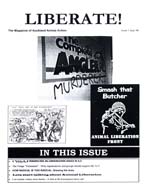
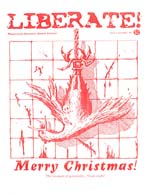
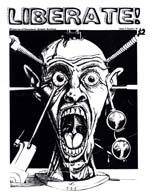
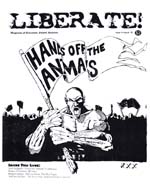
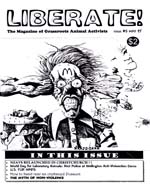
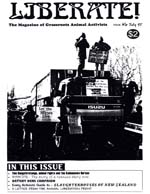
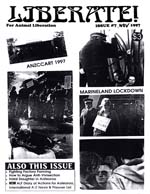
-
Periodicals, Videos
Breaking Free Video Magazine #1
10.27.11 | PermalinkBreaking Free Video Magazine #1 (1998, Eugene, OR)
Back in 1997 I was kicked out of the Liberation Collective house in Portland and moved back to my home town of Eugene. Portland was a great place for activism in those days, but Eugene didn’t have much going on… yet. So, me and an old friend decided to start an Animal Defense League chapter. Right from the start we had a tough time getting people in the streets, but we had another idea…
I grew up skateboarding, and one of the most fascinating things about that art form is how coverage of skateboarding ultimately progresses the art of skateboarding. Every time a new skate video came out kids all over the world would see new possibilities, would feel the fire lit beneath them to try new tricks, and would find courage to do so because they had just seen other people do it right in front of them. They would film their tricks, and then the whole process would happen again and again, with each new video being more impressive than the one that preceded it. My buddy had just bought a top of the line video editing setup- A pentium II with a 9 gig drive, an SVS deck, and a copy of Premiere 3.2 with a $3,000 analog video capture card. Maybe we could do for activism what skate videos did for skateboarding.
The world of non-human liberation movements was fast paced and loaded with action back then. I knew that someone needed to document everything going on, but I couldn’t afford to travel and film it all. Most AR groups had a cheap camera though, so I put out the word that we wanted to get everyone’s footage for a video, and slowly the tapes started to trickle in. We learned how to edit through trial and error, and after several months of frustration in front of the computer, Breaking Free #1 was available.
The video is not perfect in any way, and there is a lot about it that embarrasses me. Still, there was nothing else quite like it at the time. Sales were high, it was translated into German and Spanish, bootleg copies were everywhere, and even mainstream publications like Animals Agenda were praising us. While I cringe at the mispronunciation of “Nietzsche,” the bad joke of an opening, and yes, the techno music, (Sorry, Mr. K!) I feel pride that we created such an accurate picture of the state of the movement, and insured that so many acts of anger, disobedience, and compassion were not forgotten. Please watch it with critical, but forgiving eyes.
…
-
No Compromise, Periodicals
No Compromise #6-7
08.23.11 | PermalinkNo Compromise #6-7 (1997. Minneapolis, MN.)
The second year of No Compromise was packed with inspiring coverage of the growth of the militant grassroots, including some of the most important events of the 90s: Tony Wong’s hunger strike, the mass arrests and police riot at the Yerkes primate center, and the World Week for Animals in Laboratories arrests at the UC Davis primate center.
Tony Wong was only 16 years old when he was convicted for a civil disobedience action at the Lazurus department store. He immediately began a hungerstrike in prison, and after a month of not eating the staff at the juvenile facility where he was being held began force feeding him animal products through a tube forcefully inserted through his nose. The brutality faced by Tony acted as a lightning rod, and soon large demonstrations and acts of sabotage rippled across the country. The most important thing that Tony did though was to set an example of dedication that others could admire and aspire to in their own lives. Sadly, Tony eventually embraced a deeply speciesist political transformation and began consuming animals again after sacrificing so much to save them.
World Week in 1997 saw miniature police riots in Georgia and California. The protests themselves were not as important as the resulting boost to the movement created by the heavy handedness of the cops. As van loads of activists traveled to these demonstrations and found themselves sharing jail cells with like minded comrades, they soon formed tighter networks which led to greater revolutionary potential. The west coast and east coast both saw an upswing in regional actions after these arrests.
No Compromise was plagued by it’s usual production and distribution delays this year. It only got two issues finished, and they didn’t make it into people’s hands on the advertised cover dates, but both of these issues are wonderful documents of their era.
No Compromise #1-5 can be found here.
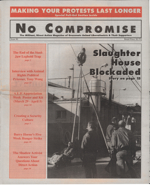
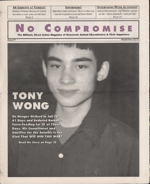
…




